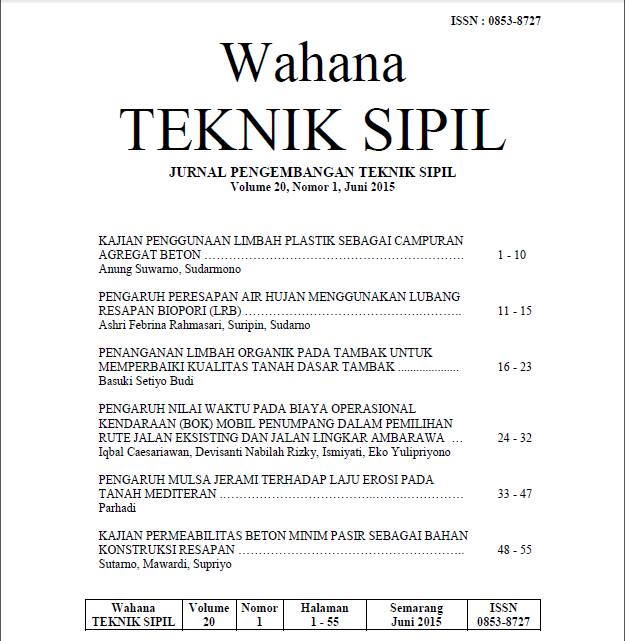Pengaruh Peresapan Air Hujan Menggunakan Lubang Resapan Biopori (LRB)
DOI:
https://doi.org/10.32497/wahanats.v20i1.139Keywords:
infiltration, LRB capacity, LRB biopore holes, Organic waste and Household wasteAbstract
The increasing of quantity and quality of community needs recipitation change the late of land use from green land which function is as water filtration and to make organic compost in LRB as water conservation and handling waste as well. This study is done by making LRB application. Filtration application is taken continues in every 60 minutes and periodic by used by used bucket and organic natural decomposition. Compost used was taken from kitchen waste, leaf litter and mixed of both of them. The density of compost varied from 0,5 kg, 2 kg, and 3 kg per hole. The observation was done in 14 weeks. Infiltration of LRB increased from the first week to nineth week and then decreased until the end of observation (fourteenth week) due to the soil pore had been recharged of water. Maximum infiltrationof LRB with 3 kg of kitchen waste then filtration of LRB with 2 kg og starfruits leaf litter and LRB with 0,5 kg of mixed waste. Infiltration rate for the first maximum were 274,79 l/h, 250,18 l/h, and 239,4 l/h. The effect of LRB was calculated based in the LRB capacity of one LRB can contained of 0,2 ;/d household waste during 20 days with 10 weeks cycle.
Downloads
Published
Issue
Section
License
Authors who publish with this journal agree to the following terms:Authors retain copyright and grant the journal right of first publication with the work simultaneously licensed under a Creative Commons Attribution License that allows others to share the work with an acknowledgement of the work's authorship and initial publication in this journal.
Authors are able to enter into separate, additional contractual arrangements for the non-exclusive distribution of the journal's published version of the work (e.g., post it to an institutional repository or publish it in a book), with an acknowledgement of its initial publication in this journal.
Authors are permitted and encouraged to post their work online (e.g., in institutional repositories or on their website) prior to and during the submission process, as it can lead to productive exchanges, as well as earlier and greater citation of published work (See The Effect of Open Access).






